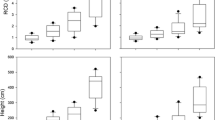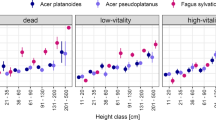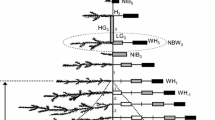Abstract
Growth of regenerating trees in different light environments was studied for the mountainous, mixed-species forests in the Carpathian Mountains of Romania. The primary species in these mixtures were silver fir (Abies alba Mill.), European beech (Fagus sylvatica L.) and Norway spruce (Picea abies (L.) Karst). Seedlings/saplings of these species were selected and measured in different stands from two different geographical locations. Regenerating trees were measured for height and diameter growth during the summer of 2002. For each seedling/sapling, percentage of above canopy light (PACL) and stand basal area (BA) were used to assess available and occupied growing space respectively. Regeneration growth was compared against these two variables and regression relationships were developed. Using these models, we predicted the dynamics of regeneration as both growth and species composition. Our results showed that in low-light environments (PACL<20–35%; BA>30 m2/ha), shade tolerant fir and beech clearly outcompeted the spruce. Therefore, in dense stands, spruce could be eliminated by the shade tolerant species. For intermediate levels of cover (PACL=35–70%; BA=15–35 m2/ha) the spruce grew at comparable rates as the beech and fir. All three species showed similar growth rates in open conditions (PACL>80–90%; BA<15–20 m2/ha) with the spruce having a tendency to outgrow the others. However, in terms of establishment, such conditions favor spruce and inhibit fir and beech.






Similar content being viewed by others
References
Anderson DR, Burnham KP, Thompson WL (2000) Null hypothesis testing: problems, prevalence, and an alternative. J Wildl Manage 64:912–923
Anderson DR, Link WA, Johnson DH, Burnham KP (2001) Suggestions for presenting the results of data analyses. J Wildl Manage 65:373–378
Assmann E (1970) The principles of forest yield study: Studies of organic production, structure, increment and yield of forest stands. Pergamon, New York
Avery TE, Burkhart HE (2002) Forest Measurements, 5th edn. McGraw Hill, Boston
Barnes VB, Zak DR, Denton SR, Spurr SH (1997) Forest ecology. Wiley, New York
Beaudet, Messier (1998) Growth and morphological responses of yellow birch, sugar maple and beech seedlings growing under a natural light gradient. Can J For Res 28:1007–1015
Brunner A (1993) Die Entwicklung von Bergmischwaldkulturen in den Chiemgauer Alpen und eine Methodenstudie zur ökologischen Lichtmessung im Wald. Forstliche Forschungsberichte München 128
Brunner A, Huss J (1994) Die Entwicklung von Bergmischwaldkulturen in den Chiemgauer Alpen. Forstw Cbl 113:194–203
Burnham KP, Anderson DR (1998) Model selection and inference: a practical information-theoretic approach. Springer, Berlin Heidelberg New York
Canham CD, Finzi AC, Pacala SW, Burbank DH (1994) Causes and consequences of resource heterogeneity in forests: interspecific variation in light transmission by canopy trees. Can J For Res 24:337–349
Collet C, Lanter O, Pardos M (2002) Effects of canopy opening on the morphology and anatomy of naturally regenerated beech seedlings. Trees 16:291–298
Dupré S, Thiebaut B, Tessier Du Cros E (1986) Morphologie et architecture des jeunes hêtres (Fagus sylvatica L). Influence du milieu, variabilité genetique. Ann Sci For 43:85–102
Emborg J (1998) Understory light conditions and regeneration with respect to the structural dynamics of near natural temperate deciduous forest in Denmark. For Ecol Manage 106:83–95
Evans J (1984) Silviculture of broadleaved woodland. Forestry Commission Bulletin 62, UK
Finzi AC, Canham CD (2000) Sapling growth in response to light and nitrogen availability in a southern New England forest. For Ecol Manage 131:153–165
Florescu II, Nicolescu NV (1998) Silvicultura, vol II. - Silvotehnica. Editura Universitatii Transilvania din Brasov, Brasov
Gendron F, Messier C, Comeau PG (1998) Comparison of various methods for estimating the mean growing season percent photosythetic photon flux density in forests. Agric For Meteorol 92:55–70
Grassi G, Bagnaresi U (2001) Foliar morphological and physiological plasticity in Picea abies and Abies alba saplings along a natural light gradient. Tree Physiol 21:959–967
Haralamb A (1967) Cultura speciilor forestiere, Editia a 3 a. Editura Agro-Silvica, Bucuresti
Helms JA, Standiford RB (1985) Predicting release of advanced reproduction of mixed conifer forests in California following overstory removal. For Sci 31:3–15
Holmes RL (1983) Computer-assisted quality control in tree-ring dating and measurement. Tree Ring Bull 43:69–75
Jackson LWR, Harper RS (1995) Relation of light intensity to basal area of short-leaf pine (Pinus echinata) stands in Georgia. Ecology 36:158–159
Latham PA, Zuuring HR, Coble DW (1998) A method for quantifying vertical forest structure. For Ecol Manage 104:157–170
Lieffers VJ (1999) Predicting and managing light in understory of boreal forests. Can J For Res 29:796–811
Messier C, Parent S (1997) Reply—The effects of direct-beam light on overcast-day estimates of light availability: on the accuracy of the instantaneous one-point overcast-sky conditions method to estimate mean daily %PPFD under heterogeneous overstory canopy conditions. Can J For Res 27:274–275
Negulescu EG, Ciumac G (1959) Silvicultura. Ministerul agriculturii si silviculturii—Editura agro-silvica de stat, Bucuresti
O’Hara KL (1996) Dynamics and stocking-level relationships of multi-aged ponderosa pine stands. For Sci Monogr 33:
Oliver CD, Larson BC (1996) Forest stand dynamics. Wiley, New York
Padraic MJ, Huss J, McCarthy R, Pfeifer A, Hendrick E (1998) Growing broadleaves: silvicultural guidelines for ash, sycamore, wild cherry, beech and oak in Ireland. COFORD-National Council for Forest Research and Development, National University of Ireland, Belfield, Dublin
Parent S, Messier C (1996) A simple and efficient method to estimate light availability under a forest canopy. Can J For Res 26:151–154
Patterson AE (1957) Distinguishing annual rings in diffuse porous tree species. J For 2:126
Savill PS (1991) The silviculture of trees used in British forestry. CAB International,Wallingford, UK
Stanescu V, Sofletea N, Popescu O (1997) Flora forestiera lemnoasa a Romaniei. Editura Ceres, Bucuresti
Stancioiu PT and O’Hara KL (2005) Morphological plasticity of regeneration subject to different levels of canopy cover in mixed-species, multiaged forests of the Romanian Carpathians. (in press) Trees: Structure and function
Thiebaut B (1986) Approches des hêtres (Fagus sylvatica L), diversité intraspecifique, approche qualitative et quantitative. Naturalia monspeliensia. Colloque international sur l’arbre, pp 246–261
Thiebaut B, Cuguen J, Dupré S (1985) Architecture des jeunes hêtres (Fagus sylvatica L). Can J Bot 63:2100–2110
Wellner CA (1948) Light intensity related to stand density in mature stands of western white pine type. J For 46:16–19
Acknowledgements
The National Forest Administration and Retezat National Park granted access to field sites and inventory data. Access to laboratory supplies and technology was provided by Faculty of Biology and Geology (“Babes-Bolyai” University, Cluj, Romania) and by Traian Cadariu (Orastie, Romania). Assistance provided by Daniel Vasiu with field and laboratory work is greatly appreciated.
Author information
Authors and Affiliations
Corresponding author
Additional information
Communicated by Jürgen Bauhus
Rights and permissions
About this article
Cite this article
Stancioiu, P.T., O’Hara, K.L. Regeneration growth in different light environments of mixed species, multiaged, mountainous forests of Romania. Eur J Forest Res 125, 151–162 (2006). https://doi.org/10.1007/s10342-005-0069-3
Received:
Accepted:
Published:
Issue Date:
DOI: https://doi.org/10.1007/s10342-005-0069-3




